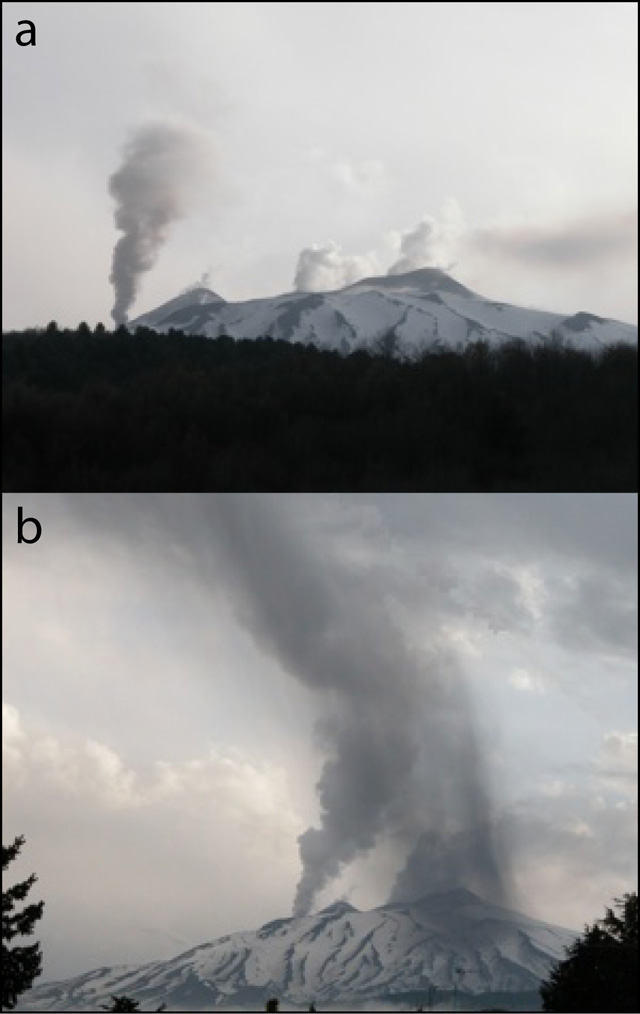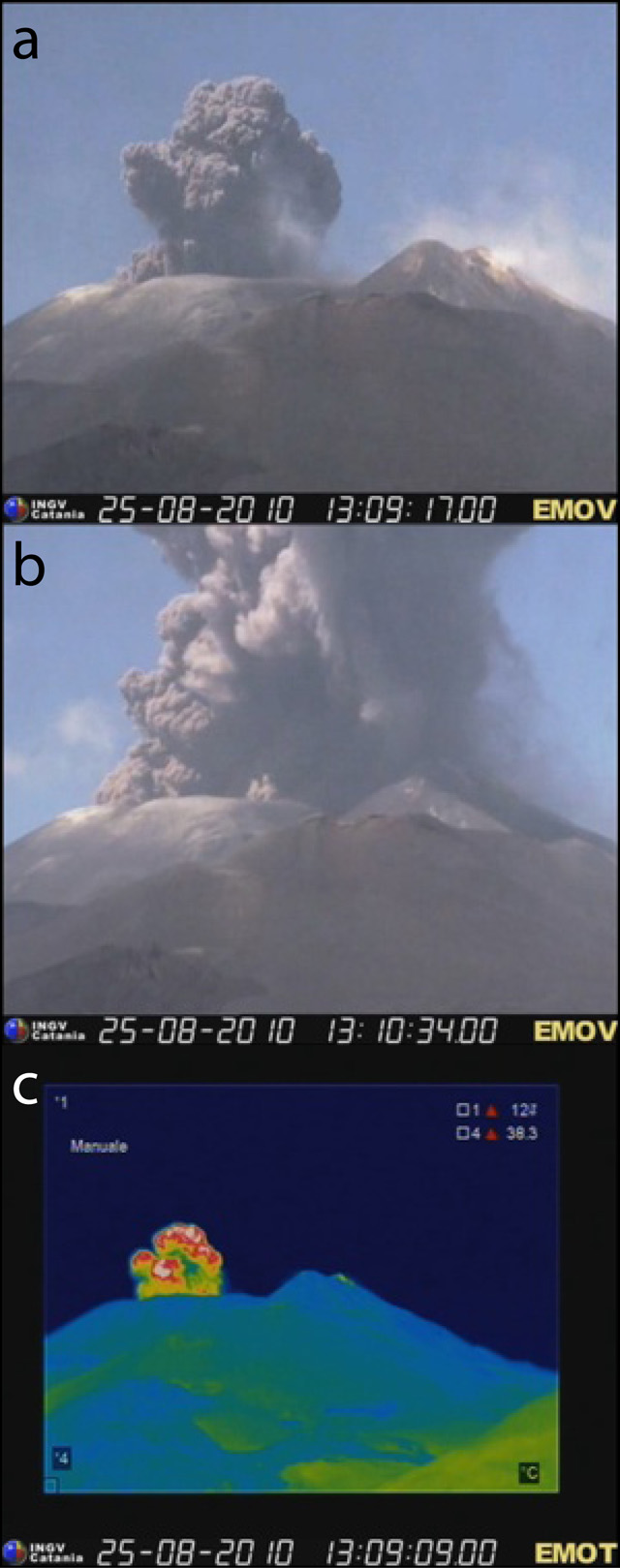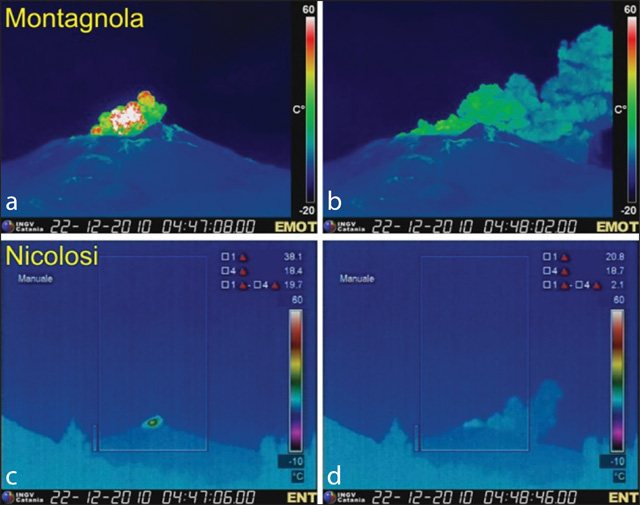Report on Etna (Italy) — February 2012
Bulletin of the Global Volcanism Network, vol. 37, no. 2 (February 2012)
Managing Editor: Richard Wunderman.
Etna (Italy) Sporadic summit activity and pit crater collapse in late-2009 and 2010
Please cite this report as:
Global Volcanism Program, 2012. Report on Etna (Italy) (Wunderman, R., ed.). Bulletin of the Global Volcanism Network, 37:2. Smithsonian Institution. https://doi.org/10.5479/si.GVP.BGVN201202-211060
Etna
Italy
37.748°N, 14.999°E; summit elev. 3357 m
All times are local (unless otherwise noted)
This report, summarized by the Istituto Nazionale de Geofisica e Vulcanologia - Osservatorio Etneo, Catania (INGV-OE), covers the time interval from 10 November 2009 through 31 December 2010 and discusses activity at Etna since our last Bulletin report (BGVN 36:05), which covered activity through 10 November 2009.
For six months following the end of the May 2008 to July 2009 flank eruption, Etna passively degassed from the summit craters. Beginning in the evening of 6 November 2009, a pulsating red glow was observed from a small pit that had opened at the eastern base of the South-East Crater (SEC) at 3,050 m elevation. This continued for several months, visible only at night from the INGV web camera, and was interpreted as being related to Strombolian activity entirely confined to the interior of the pit (and thus not directly visible). The incandescence was sometimes accompanied by small lithic ash emissions from the pit, probably associated with inner collapses.
For about 30 minutes during the afternoon of 8 April 2010, the stations of the Permanent Seismic Network recorded 12 large low-frequency events located at Etna's summit. At the same time, the pit crater at the eastern base of the SEC collapsed, producing a dark-colored plume of volcanic ash that rose to ~1 km and dispersed to the NE. Mainly lithic ash fell at distances of up to 6 km from the volcano, and the pit widened from ~40 m to ~80 m in diameter. An explosive component in this event was evidenced by a small pyroclastic density current that moved a few hundred meters to the NE from the pit. All other summit craters of Etna displayed only passive degassing.
At about 1840 on the same day, dark emissions were also observed at the central crater, the location of two active vents, Bocca Nuova and La Voragine ("The Chasm"). The phenomenon was observed by INGV-OE staff in the Pernicana-Linguaglossa area of the volcano, who also reported the fallout of ash in the Rocca Campana area, between Milo and Fornazzo. Photos taken by R. Azzaro showed an initial ash emission from the pit crater at Etna's SEC at 1800 (figure 138a), followed at about 1840 by emissions also from the central crater, and ash fallout on the NE flank.
On 9 April intense gas emissions were noted at the pit crater, but without ash emission.
INGV-OE reported a series of landslides on 19 June from the NW rim of the pit crater located on the lower E side of the SEC. The collapses generated small ash clouds that drifted NE and changed the pit crater's morphology. Data from a fixed thermal monitoring camera showed thermal anomalies over 180°C, indicating that the landslide material was hot. Fumarolic activity was seen in the landslide source area during an inspection on the previous day. The events on 19 June also formed a large gap on the NW side of the crater rim.
INGV-OE reported that at 1509 on 25 August 2010 a powerful explosion occurred at the Bocca Nuova. This explosion initiated a period of ash emission that continued, at diminishing strength, for about 20 minutes. As seen in figure 139, the onset of the explosion was characterized by the emission of hot material, which was recorded as a thermal anomaly up to 170°C by the new thermal camera on La Montagnola, ~3 km S of Etna's summit craters. The visible camera on La Montagnola recorded the rapid uprise of a cauliflower-shaped, dark gray ash plume that rose to ~1 km before being blown to the E.
The explosion on 25 August 2010 was the strongest in a series of similar explosions of the western vent of the Bocca Nuova forming a sequence that began on 5 July 2010. There was no evident change in the activity of the other summit craters; deep explosions within the active pit of the NEC had been occurring continuously for several months.
The 25 August events led to ashfall reported in areas SE of Etna, including the town of Catania (27 km S). An inspection the next morning revealed that the W wall of the BN-1 crater of Bocca Nuova had collapsed. During 25-29 August 2010, a total of seven explosions were recorded.
During the first days of October 2010, INGV-OE reported that Etna's activity levels remained fairly stable. Explosions continued deep inside the NEC, but with significant fluctuations. The western depression at the Bocca Nuova was the source of an explosive event that occurred at 1127 on 7 October and generated a small ash emission. Ashfall was observed shortly thereafter at the Rifugio Sapienza, on the high southern flank of the volcano at ~1,900 m a.s.l. The event was of short duration and formed a discontinuous deposit of very fine ash. The depression crater on the lower E flank of the SEC cone emitted gas more or less continuously, sometimes in a pulsating manner. There were no significant changes at La Voragine, the E vent of the central crater.
A field inspection on the morning of 8 October revealed a low level of gas emissions without explosive activity at the NEC, the Voragine and the Bocca Nuova. In contrast, the pit crater on the E flank of the SEC cone showed dramatic degassing from an open vent on its floor, which had opened during the first half of September. The degassing took place in a pulsating manner and was accompanied by loud hissing sounds, possibly produced by deep explosive activity. The walls of the pit crater were seen to be highly unstable, and small landslides were observed during the inspection, generating small red ash clouds. There were no "fresh" juvenile products either outside or inside the crater depression, however, on the crater floor there was clearly visible coarse material (meter-sized blocks) from areas that had collapsed in recent weeks.
Following several days of minor ash emissions at the NEC, on the morning of 14 November 2010 there was a significant increase in both the frequency and the volume of ash emissions (figure 140). These emissions generated narrow plumes to a few hundred meters high, which were then dispersed by the wind to the SW on 14 November, then NE on the night of 14-15 November, and finally E on 15 November. The ash emissions occurred intermittently, alternating with periods of white gas and vapor emissions.
On 15 November INGV-OE staff visited the NEC and observed that near the cone, particularly to the S, in the northern portion of La Voragine, a few millimeters of brown ash were present on the ground. On the rim of the NEC, the deposit was up to 1 cm thick and thickest on the eastern side. The NEC's ash emissions were then rather modest, and were accompanied by nearly continuous deep rumblings, which sometimes increased.
For more than a year there had been an open degassing vent on the NEC's crater floor, which up until the previous visit to the NEC in October had a diameter of ~25 m. On 15 November, this vent was seen to be much larger, with a diameter of at least 75 m. Ash emissions from this vent were often minor, but at other times more vigorous. The NEC's inner walls were covered by reddish brown ash deposits. No coarse-grained material was observed, either in the deposits, or in the emissions. Microscopic analysis revealed much of the ash to consist of juvenile glass shards.
After more than one month of relative quiet at Etna, at 0446 GMT on 22 December, a strong explosion occurred at the western vent of the Bocca Nuova. This event generated an ash plume a few hundred meters high that blew NE, resulting in light ash falls more than 10 km away, as far as the town of Linguaglossa. Video recorded by the thermal cameras of the Montagnola (EMOT) and Nicolosi (ENT) clearly showed the emission of hot material with temperatures exceeding 60°C (figure 141a, b). A thermal anomaly was also evident in the footage recorded by the thermal camera of Nicolosi (ENT; figure 141c, d). The visible-light footage recorded by other INGV monitoring cameras did not reveal any incandescent material.
The 22 December 2010 explosion at the Bocca Nuova was probably less powerful than the one on 25 August 2010, but certainly stronger than the numerous subsequent events between late-August and late-October. Smaller emissions of reddish-brown ash continued to occur during the forenoon of 22 December.
On 23 December 2010, an intense glow from the pit crater on the E flank of the SEC cone was recorded by the visible-light monitoring camera at the Schiena dell'Asino (6 km SE of the summit craters) during a brief interval of partial visibility amidst weather clouds. At the same time, the volcanic tremor amplitude recorded by the summit seismic network of the INGV-OE showed a brief, but sharp increase. Very small and brief emissions of hot material from the pit crater were again noted on 29 December and continued for the next few days.
Geological Summary. Mount Etna, towering above Catania on the island of Sicily, has one of the world's longest documented records of volcanism, dating back to 1500 BCE. Historical lava flows of basaltic composition cover much of the surface of this massive volcano, whose edifice is the highest and most voluminous in Italy. The Mongibello stratovolcano, truncated by several small calderas, was constructed during the late Pleistocene and Holocene over an older shield volcano. The most prominent morphological feature of Etna is the Valle del Bove, a 5 x 10 km caldera open to the east. Two styles of eruptive activity typically occur, sometimes simultaneously. Persistent explosive eruptions, sometimes with minor lava emissions, take place from one or more summit craters. Flank vents, typically with higher effusion rates, are less frequently active and originate from fissures that open progressively downward from near the summit (usually accompanied by Strombolian eruptions at the upper end). Cinder cones are commonly constructed over the vents of lower-flank lava flows. Lava flows extend to the foot of the volcano on all sides and have reached the sea over a broad area on the SE flank.
Information Contacts: Boris Behncke, Istituto Nazionale di Geofisica e Vulcanologia (INGV), Sezione di Catania, Piazza Roma 2, 95123 Catania, Italy (URL: http://www.ct.ingv.it/).





